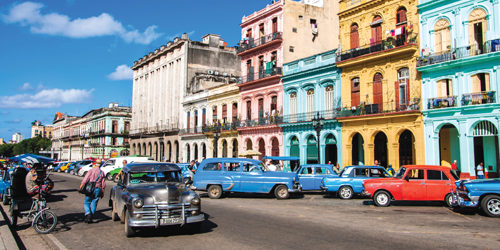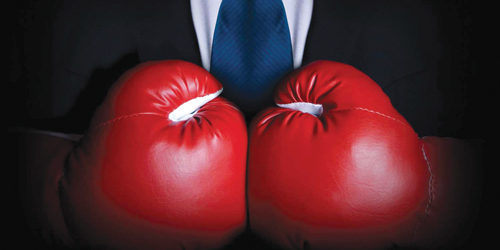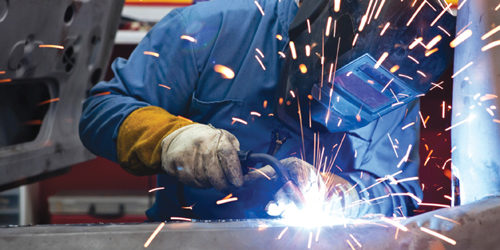
“Havana is a beautiful lady,” says my tour guide Michel, his white smile appearing in the rear-view mirror of his scarlet Mercury Monterey 1957. “The only thing she needs is a new dress.” We’re discussing Cuba’s impending American tourism boom as we cruise down the Malecon esplanade with top down, the warm breeze caressing my face and shoulders. To my right, the Gulf of Mexico’s polite waves break against an austere, grey seawall, where locals linger in pairs. To my left, is Havana. And Michel’s not wrong about the change of outfit.
Havana has a haunting beauty – a bit like the debris from an unforgettable party. Decay has knawed away at her architecture; colour has bled from the splendid Spanish colonial buildings, from the beguiling art deco frontages. And it’s a hard place to thrive. Citizens queue outside dinghy ration shops, while scam artists linger by the Maceo Monument, trying to seduce tourists into coming to a “rumba festival” with them – only to lead them to a fate of expensive knock-off cigars. People aren’t exactly salsa-ing in the streets, as some travel agents would have you believe. They’re doing what they need to get by.
We drive on to the lush embassy district of Vedado, where trees are blanketed in creepers, their chunky trunks the texture of melted wax, and the flamboyant casas are considerably more well-kept. Their owners fled to the US in the 1960s - leaving behind their belongings and their beloved luxury cars – as Fidel Castros’s new regime meant these ostentatious mansions were now property of the state. Now, they are inhabited by the descendants of the lucky beneficiaries of the Cuban Revolution, the country’s poorest people.
My visit to Cuba coincides with the end of the nine-day mourning period for Fidel Castro, after he passed away on November 25th. At the time, there was an international flurry of forecasting – what would his death mean for Cuba’s future? Though his mark on Cuba is immeasurable, it’s worth remembering that Fidel has not been in the driving seat for almost a decade. “His death really is not going to make a whole lot difference in where Cuba is on press freedom, freedom of assembly, freedom of speech and political freedom,” says American journalist Karen DeYoung in a video for The Washington Post. “I think for those people who still believe in the revolution and consider Fidel Castro the epitome of the revolution – and there are many of them in Cuba – I think that he’s a sort of symbolic figure, but not a real figure anymore in their lives, and hasn’t been for some time.”
Slow-forming but significant changes have come into play since Castro handed over power to his brother, Raul, in 2008. That year, Cubans were permitted to purchase wifi for the first time, and they were allowed to leave the island freely, without the need for exit visas or invitations, in 2013. Since 2014, the Obama administration has worked with Raul Castro to reopen mutual embassies in the two nations, re-launch direct air travel between them, and re-establish trade relations, subject to ongoing negotiations. This has seen US companies such as Google and Starwood Hotels and Resorts seek opportunities in Cuba.
And, despite Trump’s threats that he will undo the ‘deal’ if Cuba “is unwilling to make a better deal for the Cuban people, the Cuban/American people, and the US as a whole”, he has been reportedly scouting out locations in Cuba for expanding his hospitality empire…
However, plenty has stayed the same and there won’t be a sudden idealogical leap from evolved socialism to outright capitalism. Free medical care is provided to all citizens, including weekly zika checks in a community if a case is reported there. Monthly food rations are supplied to everyone - essentials such as rice, beans, meat, sugar, salt, baby food and matches. Free university education is granted to all who perform well enough at school, and the nation has a 100% literacy rate. Despite this, salaries average at US$25 per month, with half the population earning US$300-US$400 annually, with little variation between professions.
In terms of private enterprise, Cuba’s attitude has shifted over time, thanks to reforms led by Raul Castro, who recognised that if the economy failed, then so did his brother’s ultimate vision. In 2012, there were more than 385,000 entrepreneurs, accounting for 7.5 percent of the national workforce. Cuba’s niche economic conditions have cultivated a generation of hungry self-starters, and there’s a tangible sense of aspiration, from the striking number of locals converting their homes into restaurants and casa particulares (home-stays for tourists), to the overqualified hotel staff, eager to earn money and create a better life for themselves. A few entrepreneurs have even created a version of Uber, called Yotellevo (yotellevocuba.com). Due to the lack of ubiquitous 3G coverage, the service currently works over email, meaning you contact Yotellevo days in advance, stating when and where you need to travel around Cuba, and they send over three different potential drivers. (I tried the service, but my driver cancelled on me, and, for long-distance journeys, there are more competitive rates to be found on the ground with a service called Cubataxi).
Given the current fervour for visiting Cuba ‘before it changes’, and factors such as its educated population, its growing economy and its (hopefully) improved relations with the US, the tourism sector and other service-based industries present promising opportunities for international investors. However, the time-warp vibe somewhat hinders the pace of doing business, and you would need to have a long-term perspective, resourcefulness, and patience in buckets. Cuba is hard work, mainly due to the limited infrastructure and imports. Wifi is hard to come by (patchy and expensive when you do find it) and operations at Jose Marti International airport are far from slick – my flight home from Havana was delayed by 2.5 hours as there was only one ramp available to offload bags from every single plane. However, developments are taking place to accommodate the rising number of traveller, which increased by 15% in the first half of 2016 compared with the same year. In Havana for example, plans are underway to create two new cruise terminals.
After ten days travelling around the island – rumbling down its highways in vintage cars, hiking around the tobacco plantations of Vinales, and shaking maracas with a salsa band in Trinidad – I return to Havana for a luxurious end to my trip. Situated in Vedado, Paseo 206 opened in September 2016, and is hopefully a sign of things to come for the Cuban capital.
“Our family has been in the hospitality business since 1999, operating from our home in Vedado,” says Diana Sainz, the hotel’s co-owner and general manager. “Our guests were always interested in our stories and our family history, they were captivated by my father’s stories of the revolution and his overseas trips with Fidel and Che Guevuara.
“These memories left a mark on me. I knew that one day I wanted to open a hotel that offered the best rooms and service in town. After all these years, I’m proud to offer an authentic Cuban experience with the sophistication of a boutique hotel.”
Paseo 206 retains the framework of a 20th century Vedado mansion - including a grand marble staircase, wood panelling and detailed cornicing in its eight rooms – but washes it in cool, uplifting colours and adds pops of contemporary European furniture. Its wifi is free and fairly reliable, its staff are excellent, and the handmade fettucini pasta served in its restaurant is perfection.
Above all, it’s tasteful… a careful renovation of the city’s fascinating and precious history, rather than a rude intrusion. A new dress for Havana, rather than a new body. And it suits her.
WHERE TO MEET
HOTEL NACIONAL
If walls could talk, this iconic 1930s hotel would have some stories to tell; it has hosted reams of Hollywood stars, world leaders and even mafia conferences. The statuesque property has an executive floor, a business centre and ten meeting spaces, plus vast sea-facing lawns for outdoor events.
hotelnacionaldecuba.com
PASEO 206
Homey yet refined, this design-led boutique hotel has a cool-hued, oval-shaped room for private dining, featuring a carrera marble floor and a mollecular light fixture. It has space for ten people. A rooftop spa with a health bar and plunge pool is due to open in March.
paseo206.com
MELIA HABANA
Set in the affluent Miramar district, opposite the Miramar Trade Centre, this business hotel offers an executive floor named The Level, with PCs and space for informal meetings. There’s also a fitness centre, three outdoor freshwater pools and a range of restaurants suitable for business lunches.
melia.com






